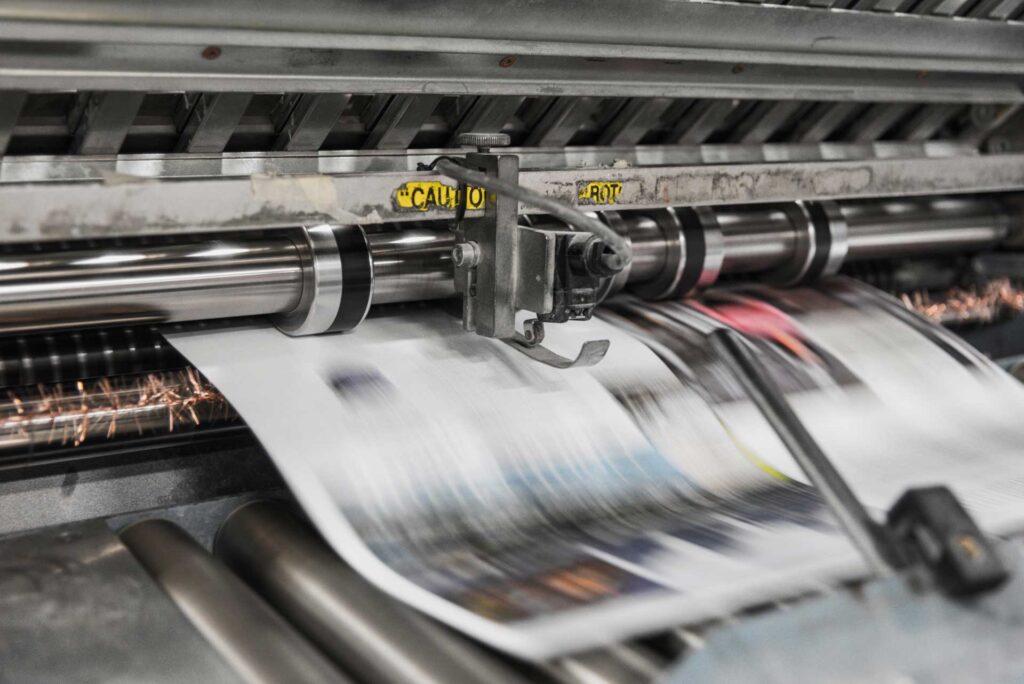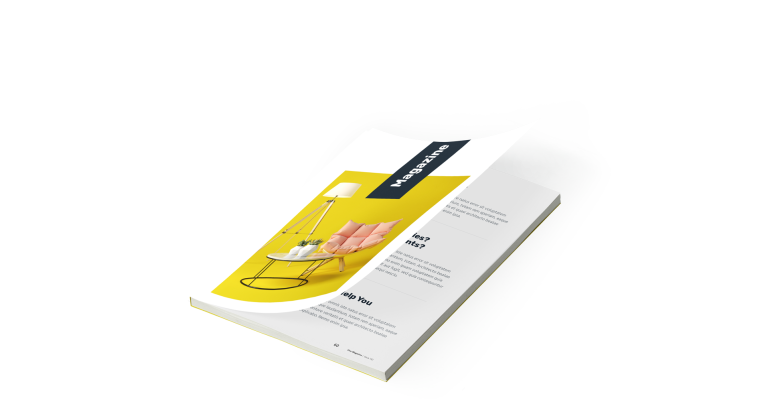A Step by Step Guide to Making a Magazine
Whether you want to create a niche magazine for a specific target audience or a digital magazine that can be accessed worldwide, this blog will guide you through how to make a magazine.
From identifying your magazine’s target audience to finalising the design and layout, we will cover everything you need to know to create a magazine that stands out.
So, let’s dive in.
What to Consider When Designing a Magazine
To create a professional-looking magazine, you will need the right tools and resources. Here are a few essentials:
- Design Software: Adobe InDesign is the industry standard for magazine layout and design. It offers a wide range of features and tools to create stunning layouts. Microsoft Word is also a viable option for simpler magazine designs.
- Stock Images: High-quality images can enhance the visual appeal of your magazine. There are many stock image websites where you can purchase or download royalty-free images for commercial use.
- Professional Designer: If you don’t have design experience or prefer to outsource the design work, consider hiring a professional magazine designer. They can bring your vision to life and ensure a polished and professional result.

It’s not easy to create a magazine. At Image Box Design, we can help design a magazine that resonates with your target audience and brand identity.
Looking for a quote, or more information? Get in touch with our experts today and we’ll be happy to help.
Assembling Your Creative Team
Creating a magazine is a collaborative effort that requires a team of talented individuals. Assemble a creative team that can contribute their skills and expertise to different aspects of the magazine.
Consider the following roles when assembling your team:
- Creative Director/Editor-in-Chief: This person will oversee the overall vision and direction of the magazine. They will guide the creative team and ensure that the magazine aligns with the intended theme and purpose.
- Graphic Designer: The graphic designer will be responsible for the visual elements of the magazine, including layout, typography, and graphics. They will work closely with the editor to bring the content to life visually.
- Writers/Contributors: Depending on the size and scope of your magazine, you may need writers or contributors to create the written content. Consider hiring experienced writers or reaching out to industry experts who can provide valuable insights and engaging articles.
- Photographer/Illustrator: If your magazine requires original visual content, you may need a photographer or illustrator to create custom images or illustrations.
- Sales Manager: If you plan to generate revenue through advertising, consider hiring a sales manager who can identify potential advertisers, negotiate deals, and manage relationships with advertisers.
Step-by-Step Guide to Creating a Magazine
Creating a magazine involves a step-by-step process that covers everything from defining your magazine’s purpose and audience to designing the layout and selecting visual content.
Follow these steps on how to make a magazine:
Step 1: Define Your Magazine’s Purpose and Audience
The first step in creating a magazine is defining its purpose and identifying your target audience. Determine what makes your magazine unique and why readers would be interested in it.
Consider the following questions:
- What topics or themes will your magazine cover?
- What value will your magazine provide to readers?
- What demographic or niche audience are you targeting?
- What sets your magazine apart from existing publications?
There are several ways to identify your target audience. You can conduct market research through surveys or focus groups to gather information about their demographics, interests, and habits.
Analysing existing data from your current readership or similar magazines can also provide insights into the demographics of your target audience. Additionally, looking at industry reports and statistics can help identify demographic trends in your specific niche or industry.
Social media analytics tools can provide valuable information about the demographics of your followers and fans. Analysing your competitors’ readership demographics can also give you an idea of who might be interested in your magazine’s topic. Another source of information is your website analytics, which can show you the demographics of visitors to your site.
Step 2: Crafting Your Magazine’s Content Strategy
Once you have defined your magazine’s purpose and audience, it’s time to craft a content strategy. This involves determining the format and structure of your magazine, as well as planning the types of content you will feature.
Consider the following:
- Decide on the format of your magazine, such as print, digital, or both.
- Determine the frequency of publication, whether it’s monthly, quarterly, or biannually.
- Plan the sections and departments that will be included in each issue.
- Define the types of content you will feature, such as articles, interviews, reviews, or tutorials.
- Consider the length and word count of articles to ensure a balanced mix of content.
Start by brainstorming ideas that align with the interests and desires of your readership. Think about the topics that are relevant to them and the type of content they would find valuable. Consider conducting surveys or focus groups to gather direct feedback from your target audience.
Once you have a list of potential content ideas, narrow it down based on what aligns with the overall theme and purpose of your magazine. Determine the main pillars or categories that will form the foundation of your content strategy.
For example, if your magazine is about healthy living, your content pillars could include nutrition, fitness, mental wellness, and lifestyle. Within each pillar, you can further break down the topics and sub-topics to create a diverse range of content.
It’s important to strike a balance between evergreen content and timely pieces. Evergreen content is timeless and can be enjoyed by readers at any time, while timely pieces are relevant to current events or trends. This balance ensures that your magazine remains relevant and valuable to your readers over time.
Remember to keep your target audience in mind throughout the content creation process. Tailor the tone, style, and language to resonate with your readers. Consider using visuals such as photographs, illustrations, and infographics to enhance the overall reading experience.
Step 3: Designing Your Magazine Layout
The layout of your magazine is an important aspect of its visual appeal and readability. Designing an aesthetically pleasing and well-organised layout will enhance the overall reading experience for your audience.
Consider the following tips when designing your magazine layout:
- Create a table of contents to guide readers through the magazine.
- Establish a consistent visual theme and style throughout the layout.
- Use appropriate fonts, colours, and graphics to create a cohesive look.
- Pay attention to the placement of articles, images, and other visual elements.
- Ensure that the layout is easy to navigate and that important information is easily accessible.
Start by determining the visual style and theme of your magazine. Consider the mood you want to evoke and the emotions you want to elicit in your readers. This will guide your decisions regarding colour schemes, typography, and graphic styles.
When it comes to layout, plan the overall structure of the magazine. Decide on the number of pages, the placement of articles, and the arrangement of visuals.
Don’t be afraid to experiment with different design elements and layouts to create a unique and engaging magazine. Test different options and gather feedback to refine your design choices. With a well-planned and visually appealing design, your magazine will stand out and capture the attention of your target audience.
Step 4: Selecting and Creating Visual Content
Visual content plays a crucial role in capturing readers’ attention and enhancing the overall aesthetic of your magazine. Here are some tips for selecting and creating visual content:
- Use high-quality stock images to supplement your articles and enhance the visual appeal of your magazine.
- Consider commissioning or creating custom illustrations or artwork that align with your magazine’s theme and style.
- Choose a captivating cover image that grabs readers’ attention and reflects the content of the magazine.
- Incorporate visuals such as infographics, charts, and diagrams to visually represent data or complex information.
- Include photographs or other visuals that accompany and enhance your articles.
- Optimise images for print or digital display to ensure they look their best.
Step 5: Writing Compelling Articles
The articles in your magazine are the heart of the content and play a crucial role in capturing and retaining readers’ interest. Here are some tips for writing compelling articles:
- Identify topics that are relevant and interesting to your target audience.
- Craft compelling headlines that grab readers’ attention.
- Use storytelling techniques to engage readers and make your articles more relatable.
- Create a mix of short, snappy articles and longer, in-depth features to cater to different reading preferences.
- Consider featuring articles that are part of a series to keep readers coming back for more.
- Incorporate quotes, anecdotes, and real-life examples to add depth and credibility to your writing.
Step 6: Editing and Proofreading
Before finalising your magazine, it’s essential to edit and proofread your content to ensure accuracy, clarity, and consistency. Here are some tips for effective editing and proofreading:
- Review content for grammar, spelling, and punctuation errors.
- Check for consistency in style, tone, and formatting throughout the magazine.
- Ensure that headlines, subheadings, and captions are clear and concise.
- Verify the accuracy of facts, statistics, and references.
- Consider seeking feedback from others, such as peers or professional editors.
- Proofread the final version of your magazine carefully to catch any remaining errors.
Step 7: Finalising the Magazine Design
Once you have planned the overall aesthetic and layout of your magazine, the next step is to finalise the design. This involves making decisions regarding the visual elements, typography, and overall look and feel of the magazine.
Considerations when finalising the magazine design include:
- Visual Elements: Choose appropriate images, illustrations, and graphics that align with the content and target audience of the magazine. High-quality and visually appealing images can enhance the overall reading experience.
- Typography: Select suitable fonts, font sizes, and font styles for the magazine. The typography should be legible and consistent throughout the publication.
- Layout: Arrange the elements on each page, including text, images, and advertisements, in an organised and visually pleasing manner. Pay attention to the balance between white space and content.
- Back Page: The back page of the magazine is an important space that can be used for various purposes. Consider including a compelling cover image, a teaser for the next issue, or additional content related to the magazine’s theme.
Step 8: Printing and Publication Options
Once you have finalised the design of your magazine, the next step is to explore the printing and publication options available to you. This step involves deciding whether to create a print version, a digital magazine, or both.
Here are some printing and publication options to consider:
| Option | Description |
| Print Version | This option involves printing physical copies of the magazine. It allows for a tangible reading experience and can be distributed to bookstores, newsstands, and subscribers. However, it requires printing and distribution logistics, and the cost can be higher compared to digital publishing. |
| Digital Magazine | A digital magazine can be accessed on electronic devices such as smartphones, tablets, and computers. It offers convenience and accessibility to a wider audience. Digital magazines can be distributed through websites, apps, and social media platforms. They can incorporate interactive features such as videos, links, and animations. Additionally, digital magazines can be easily shared and archived. |
| Hybrid Approach | Consider a combination of print and digital publishing. This approach allows you to cater to different reader preferences and reach a wider audience. You can offer a print version for those who enjoy the tactile experience of flipping through pages and a digital version for those who prefer the convenience of accessing content online. |
When deciding on the printing and publication options, consider factors such as your target audience, budget, distribution channels, and overall goals for the magazine. A combination of print and digital publishing can provide the best of both worlds and maximise the reach of your magazine.

Looking For Help With Your Magazine Design?
Whether you’re a business owner looking to promote your products or services, a content creator wanting to share your expertise or an aspiring magazine publisher, we can help make your magazine a success.
Are you ready to create a magazine that stands out? Get started today!
At Image Box Design, we help brands and businesses across the UK design their marketing materials. Get in touch with us for a free consultation to find out how we can help.
If you’d like a quote, call us on 0118 969 4000 or complete our online form and we’ll get in touch as soon as possible.
Frequently Asked Questions
How is a magazine made?
You can design a magazine with eye-catching graphics and your own content. There are online tools and templates to help, but collaborating with a graphic designer is a great way to achieve a professional look.
How many pages is a magazine?
The number of pages varies, but most magazines range from 20 to 100+ pages depending on the content and target audience (think National Geographic vs. a local fashion zine).
How can I create magazine content?
Write informative articles, capture your own images, or source compelling content. Consider interviews, features, and visuals like infographics to keep readers engaged.
What is the format of a magazine?
Magazines typically use a rectangular format with a cover, masthead (logo and title), articles, images, and advertisements. Content is arranged in a clear hierarchy for easy reading on paper or mobile devices.
How can I create an online magazine?
Use online tools and free magazine templates to design your digital publication. Focus on mobile-friendly layouts and high-quality visuals. Promote your magazine on social media (Facebook) or through online communities.
Related Guides:
- What is Print Design?
- What is Brand Identity?
- How to Design a Roller Banner
- What are Bleed and Crop Marks?
- What is Graphic Design?
- What is Print Media?
- What is Logo Design?
- What is an Infographic?
- How to Design a Poster
- What Makes a Good Poster?
- Why Branding is Important for Your Businesses Success
- 10 Signs Your Business Needs a Rebrand
- 7 Reasons Why Typography is Important
- 12 Advantages of Print Advertising
- 15 Tips For Choosing The Best Graphic Design Company
- 17+ Reasons Why Graphic Design is Important for Businesses



